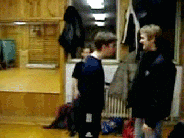This is it. We’ve reached the end. I know, I can’t even believe it.

Source: Giphy
My CTW class has finished and all of my research has come to a close. While I admit, I won’t be missing writing papers late at night, I’ll will miss showing up to this class. This is one of the first english classes that I’ve taken where I felt like my writing had purpose. Coming into college, I didn’t have a lot of confidence in my own writing and none of my previous teachers did a very good job of teaching me how I could change it for the better. This class helped develop my writing academically through research papers as well as casually through my blog posts. This class has taught me some of the most important writing skills that I will continue to use for the rest of my life. In addition, I learned a whole lot about the research process.
Taking it back to the beginning, we started to prepare ourselves for all the research we would be performing by doing a little reading. Does BEAM, hunter/gatherers, and Kantz sound a little bit familiar? As I discussed in my earlier blog posts, these were some of the readings that had an impact on my ideas surrounding research. Here were my main key points I learned from reading these three articles:
- There are different types of sources: background, exhibit, arguments, and methods. Using the correct type of source in the right manner can greatly improve your paper and the points you want to make. Identifying what type of source it is can also help you find other sources that fit in the other categories.
- When you start researching, it’s ok to look broadly. This will give you an idea of who is talking about your topic and where you might want to find other sources. But once you do get that broad sense, you should narrow down your sources and look for articles that directly relate to your research.
- Research is not about re-stating what has already been said. It’s your job as a researcher to “enter the conversation” and offer your own perspective on the topic.
- It’s good to include sources that both support and argue against your claim.
- Use metacommentary to clarify your points and lengthen your paper!
Also throughout this quarter, I’ve had practice researching in the archives and surfing through the database. I now appreciate the value of the archives and the kind of first-hand experience and knowledge I can gain from it. In terms of the database, I know how to narrow down my searches by using * and ” “. I can also identify the different types of sources and how to cite directly from the database.
There are so many sources available for students to use, but so very few actually know how to use them all properly. I’ve learned a lot about research and plan on applying my processes to other classes. In conclusion, this class has taught me how to become a better writer and a great researcher.
Well, it’s time for me to wrap up my blog. It’s been a pleasure writing for you all and I wish you all the best in your writing careers! Peace out!

Source: Giphy








